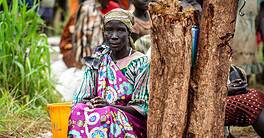As the number of physical banks in Africa diminishes, can existing institutions keep up with rising demand and the challenge of digital banking?

For the past quarter-century, banks have endured despite Bill Gates’ famous dictum “Banking is necessary; banks are not.” Can they do it for another 25 years?
In Africa, the answer comes in a shade of grey. Long-term survival for brick-and-mortar banks is proving difficult. “In terms of physical branches, Gates is right,” says John Gachora, managing director of Kenya’s NCBA Group. But banks, in the form of well-regulated, governed and managed entities that foster trust, are here to stay, he adds.
Across the continent, the number of banks is declining, driven by tightening regulations, mergers and acquisitions, liquidations and collapses. In Nigeria, only 27 remain out of 89 that existed in 2004. Kenya has seen 10 completed M&A deals and two collapses since 2016.
Despite the erosion, some banks are flourishing thanks to a commitment to keeping pace with changing market dynamics. “Banks are being forced to innovate,” says Joshua Oigara, chief executive at KCB Group, Kenya’s biggest bank by asset value, at just over $8 billion, a substantial chunk of which it amassed through the acquisition of the National Bank of Kenya last year.
Disruptors are having a powerful impact. In South Africa, cloud-based TymeBank had attracted 1 million customers by last November, after less than a year of operation. In Kenya, telecom-giant Safaricom, in partnership with Commercial Bank of Africa, is revolutionizing financial inclusion by offering easy access via mobile-phone app without need for an account, credit access and now savings. In Nigeria, fintechs are on the rise as mainstream banks struggle to recover from a confidence crisis.
Regulators Get Tough
Regulators, meanwhile, are becoming more stringent. Across the continent, policymakers have come under intense pressure to reign in banks’ push for super profits, generating new laws like the capping of interest rates in Kenya. The law was repealed last November after lending to the private sector shrank to just 1.6% of GDP from a high of 25% in mid-2014, according to the World Bank.
Regulators are struggling to keep up with industry trends like cybersecurity, open banking, green financing, and lack of consumer protection in digital financial services and processing of consumer data. But this leaves banks with little room to experiment. A few watchdogs, like the South African Reserve Bank, are willing to ease their rigid stance and obsession with risk-based supervision. “Regulators are willing to be open-minded,” says Gachora, but they must protect the basic principle of banking: trust.
In the face of an uncertain future, African banks are starting the decade on a negative note, underscored by a Moody’s downgrade from a stable forecast due to a negative outlook. Most banks, however, retain sound funding and liquidity. “Their capital buffers will be sufficient to absorb some unexpected losses,” says Constantinos Kypreos, Moody’s senior vice president covering Africa, the Middle East and the Balkans.
With the downgrade, the future of African banking is shaping up as a rollercoaster ride that will yield a condensed and solid sector favoring size, tolerating niches and annihilating laggards. As mobile and digital banking sweep the landscape, and the pressure to be more customer-centric weighs on operations, many banks will experience a rough ride. Mobile banking, in particular, is revolutionizing sub-Saharan Africa, serving 21% of adults the market, according to the World Bank.
It’s not all gloom and doom, however. Research by McKinsey found that banks in Africa that reset their strategy face vast opportunities. The consulting firm projects that the number of banked Africans will hit 450 million by 2022, up from 300 million in 2017, spurred by new retail customers. “Africa’s retail banking penetration stands at just 38% of GDP,” McKinsey pointed out in a February 2018 report, adding the figure is “half the global average for emerging markets.”
Apart from customer growth, Africa is the second most-profitable region after Latin America for banking, with return on equity at 14.9% compared to a 9% global average. Between 2012 and 2017, revenue pools saw a compound annual growth rate of 11%; and McKinsey projects growth around 8.5% annually to 2022.
The exit of global banks like Barclays Bank opens new streams of business from corporate clients, both local and international. So does an emerging sector of small and medium-sized enterprises yearning for growth capital. Growth is also projected from drawing more people in the formal banking sector, segments that for instance Trust Merchant Bank (TMB) has successfully exploited in the Democratic Republic of Congo.
“TMB has invested significantly in its ability to deliver banking services right across the country, including rural and remote areas,” observes CEO Oliver Meisenberg. In 2018, the bank reported that one in five DRC bank accounts were with TMB.
For African banks, strategically crafting the future involves choosing the right geographic presence and the right market segment or segments, and creating compelling product offering: leaner, simpler banking; digital adoption; and innovation in risk profiles.
Segmentation could be a key revenue driver. McKinsey projects that by 2025, 70% of the growth in Africa’s retail banking revenue pools will come from the middle segments: individuals earning an annual income between $6,000 and $36,000.
Fine-Tuning The Customer Base
Banks must also cater to more-finely differentiated audiences, developing customer-centric business models to serve both more and less traditional clients and optimizing distribution between traditional, physical branches and digital channels. They must foster innovation while proactively managing risk, regulation and capital.
Critically, 65% of consumers in East Africa prefer a local bank branch, and 25% say they would not open an account with a bank that does not have at least one. “Consumers still value the ability to ask for help and be guided through the process—in person,” concludes PwC’s East Africa Banking Survey 2019.
The shifting dynamics among African banks includes a growing belief that bigger is better. This cuts across customer perceptions of deposit safety, risk management, stability and economies of scale, among other concerns. “Customers believe bigger is safer,” says Gachora, and this contributes to the urge to merge. NCBA, birthed from the merger of two second-tier lenders last year, is now the third-biggest bank in Kenya in terms of asset value at $4.4 billion.
In Africa’s major economies, homegrown banks are pursuing growth beyond their markets—but with mixed results.
Africa’s largest bank by assets, Standard Bank, is reaping the benefits. With the South African economy on its knees and posting flat returns, operations outside its home market were responsible for the 5% growth in profitability that Standard posted in the first half of 2019, according to the bank.
Standard Bank plans to increase its presence in francophone West Africa, reckoning that its representation across the sub-Saharan region puts it in a good position to benefit from the continental free trade agreement that came into force last May, creating a borderless market of more than $3 trillion.
In the DRC, where several pan-African banks are flocking, TMB is shrugging off threats to its steady growth and profitability. “We have continuously outperformed the pan-African banks in growing market share and profitability,” CEO Meisenberg says: an indication of not only the obstacles facing pan-African banks but also the determination of local lenders to protect their turf.
Given the pressure to pursue growth, African banks cannot afford to drop their guard regarding risk, either. Traditionally, credit, liquidity and market risks have been the main torment. New and emerging threats–including anti-money laundering requirements, fraud and cyberattacks–will demand greater investment in systems and personnel. And compliance with IFRS 9, which requires an entity to recognize a financial asset or liability on its statement of financial position when it becomes party to the contractual provisions of the instrument, is forcing banks to anticipate and plan in line with the fast-paced changes in customer behavior and the marketplace.
From all sides, then, African banks face challenges, but a dynamic and fast-growing business is at their fingertips.



